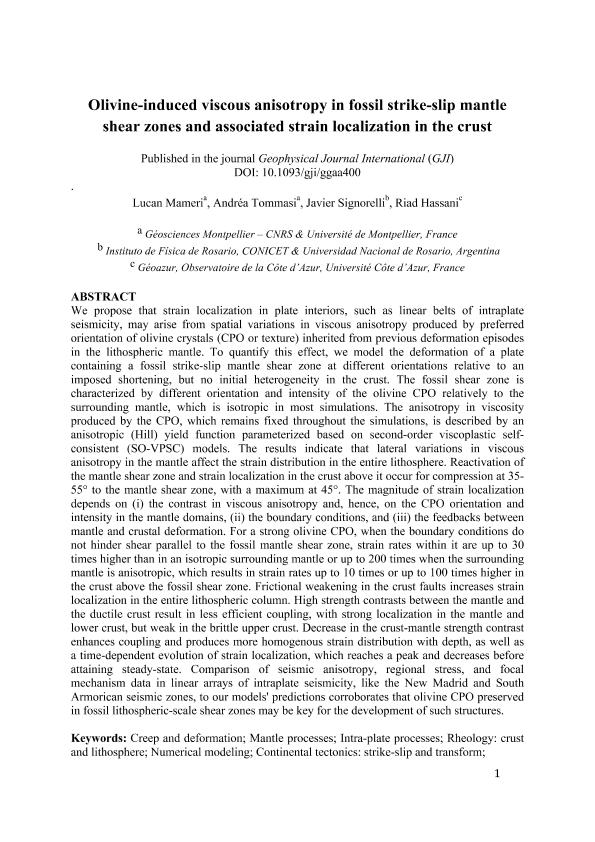Artículo
Oliine-induced iscous anisotropy in fossil strike-slip mantle shear zones and associated strain localization in the crust
Fecha de publicación:
01/2021
Editorial:
Wiley Blackwell Publishing, Inc
Revista:
Geophysical Journal International
ISSN:
0956-540X
Idioma:
Inglés
Tipo de recurso:
Artículo publicado
Clasificación temática:
Resumen
We propose that strain localization in plate interiors, such as linear belts of intraplate seismicity, may arise from spatial ariations in iscous anisotropy produced by preferred orientation of oliine crystals (CPO or texture) inherited from preious deformation episodes in the lithospheric mantle. To quantify this effect, we model the deformation of a plate containing a fossil strike-slip mantle shear zone at different orientations relatie to an imposed horizontal shortening, but no initial heterogeneity in the crust. The fossil shear zone is characterized by different orientation and intensity of the oliine CPO relatiely to the surrounding mantle, which is isotropic in most simulations. The anisotropy in iscosity produced by the CPO, which remains fixed throughout the simulations, is described by an anisotropic (Hill) yield function parametrized based on second-order iscoplastic self-consistent (SO-PSC) models. The results indicate that lateral ariations in iscous anisotropy in the mantle affect the strain distribution in the entire lithosphere. Reactiation of the strike-slip mantle shear zone and strain localization in the crust aboe it occur for horizontal compression at 35-55? to the fossil shear plane, with a maximum at 45?. The magnitude of strain localization depends on (i) the contrast in iscous anisotropy and, hence, on the ariations in CPO orientation and intensity in the mantle, (ii) the boundary conditions and (iii) the feedbacks between mantle and crustal deformation. For a strong oliine CPO, when the boundary conditions do not hinder shear parallel to the fossil mantle shear zone, strain rates within it are up to a factor 30 higher than in an isotropic surrounding mantle or up to a factor 200 when the surrounding mantle is anisotropic, which results in strain rates up to a factor 10 or up to a factor 100 higher in the crust right aboe the fossil shear zone. Frictional weakening in the crust faults increases strain localization in the entire lithospheric column. High strength contrasts between the mantle and the ductile crust result in less efficient mechanical coupling, with strong localization in the mantle and lower crust, but weak in the brittle upper crust. Decrease in the crust-mantle strength contrast enhances the coupling and produces more homogenous strain distribution with depth, as well as a time-dependent eolution of strain localization, which reaches a peak and decreases before attaining steady-state. Comparison of seismic anisotropy, regional stress and focal mechanism data in linear arrays of intraplate seismicity, like the New Madrid and South Armorican seismic zones, to our models' predictions corroborates that oliine CPO presered in fossil lithospheric-scale shear zones may be key for the deelopment of such structures.
Archivos asociados
Licencia
Identificadores
Colecciones
Articulos(IFIR)
Articulos de INST.DE FISICA DE ROSARIO (I)
Articulos de INST.DE FISICA DE ROSARIO (I)
Citación
Mameri, Lucan; Tommasi, Andrea; Signorelli, Javier Walter; Hassani, Riad; Oliine-induced iscous anisotropy in fossil strike-slip mantle shear zones and associated strain localization in the crust; Wiley Blackwell Publishing, Inc; Geophysical Journal International; 224; 1; 1-2021; 608-625
Compartir
Altmétricas




